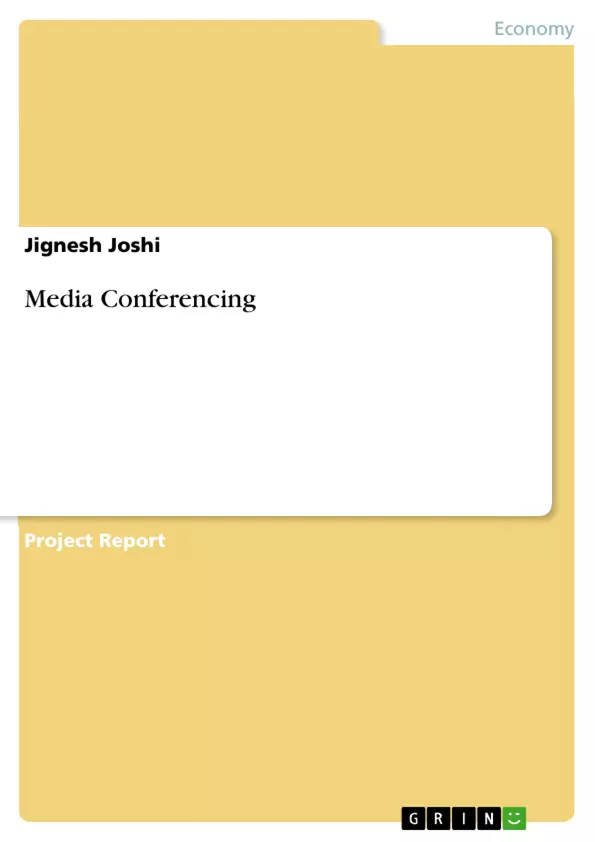Communication is the process by which any message is given or received through talking, writing, or making gestures.
Text chat is the oldest and widest means of communication and it is largely employed over the internet as it requires least bandwidth.
Voice chat has led to a significant increase in distant communications where two or more people from opposite ends of the world can talk almost free of cost. It is replacing the telephony calls as they are expensive.
Video chat is a peer-to-peer communication where recipient and sender interact via video and audio transmissions simultaneously. Video conferencing is a multi-way communication. Recipients can transmit back to the sender. It is a way for presentations or meetings to be "broadcast" or “unicast” over a network (e.g. the Internet) to a select group of
people who may be quite a distance from the actual event. The live video is sent over the network by the means of a streaming program.
Inhaltsverzeichnis (Table of Contents)
- Introduction
- Current Scenario
- Architecture
- Design
- Methodology
- Packages
- javax.media
- java.io
- javax.swing and java.awt
- java.net
- Comparision of Protocols
- For Text Data Transfer
- For Audio and Video Data Transfer
- Results and Discussions
- Conclusion and Future Work
Zielsetzung und Themenschwerpunkte (Objectives and Key Themes)
This project aims to develop a robust and efficient application for media conferencing, leveraging various protocols and technologies to overcome challenges related to real-time multimedia data transfer over the internet. The main objectives include:- Minimizing the impact of network congestion on video playback quality.
- Exploring effective ways for data transfer over the internet.
- Developing an application that supports various communication facilities like text chat, audio chat, and video chat.
- Analyzing and comparing the performance of different protocols for real-time media streaming.
- Utilizing multicast addresses to reduce server load during conferencing sessions.
Zusammenfassung der Kapitel (Chapter Summaries)
- Introduction: This chapter introduces the growing demand for efficient data transfer over the internet, particularly for multimedia content. It highlights the challenges posed by network congestion and the need for appropriate protocols to ensure quality data transfer. The importance of real-time multimedia data transfer is emphasized, leading to the introduction of RTP protocol and JMF API for efficient multimedia communication.
- Current Scenario: This chapter explores the current state of real-time video communication over the internet, outlining its challenges. The variable bit rate of real-time video, the need for frame periodicity preservation, and the limited tolerance for data loss are discussed. The concept of heterogeneity in multicast video distribution, where different receivers have different processing capabilities and bandwidth, is also presented.
- Design: This chapter details the design of the media conferencing application. The server-client architecture is explained, outlining the roles and responsibilities of each component. The project utilizes object-oriented methodology implemented in Java, taking advantage of its network and multi-tasking capabilities. The chapter also describes the various Java packages used for GUI design, networking, and media processing.
- Comparision of Protocols: This chapter compares the characteristics and suitability of different protocols for text and multimedia data transfer. TCP, UDP, and RTP are compared in terms of security, reliability, speed, and multicast support. The analysis reveals the advantages and disadvantages of each protocol for real-time data transfer.
- Results and Discussions: This chapter presents the results of the project, demonstrating how the developed application addresses the challenges of real-time media conferencing. The use of multicast addresses for conferencing and the benefits of MBONE architecture are highlighted. The chapter also discusses the selection of protocols based on specific requirements, such as TCP for secure login data and UDP or RTP for text chat and audio/video data.
Schlüsselwörter (Keywords)
The project focuses on the efficient transfer of real-time multimedia data over the internet, incorporating technologies like RTP protocol and JMF API. Key concepts explored include:- Media conferencing
- Real-time data transfer
- Network congestion
- Multicast addresses
- RTP protocol
- JMF API
- Citar trabajo
- Jignesh Joshi (Autor), 2009, Media Conferencing, Múnich, GRIN Verlag, https://www.grin.com/document/126602



